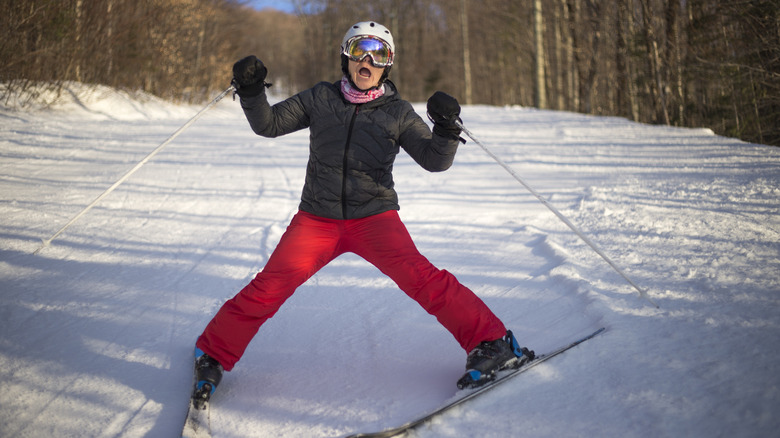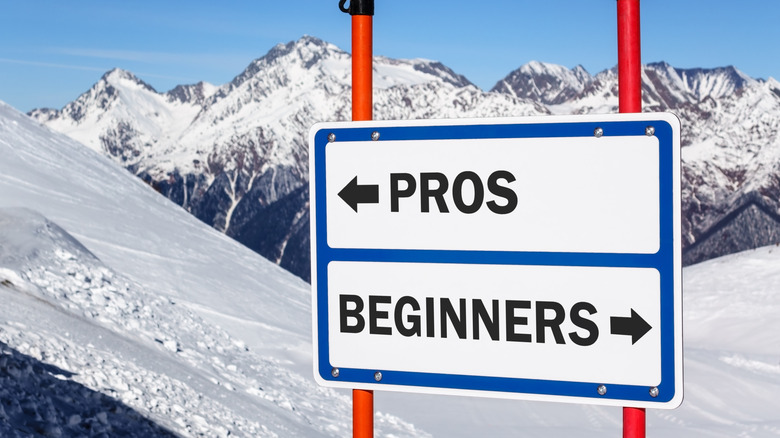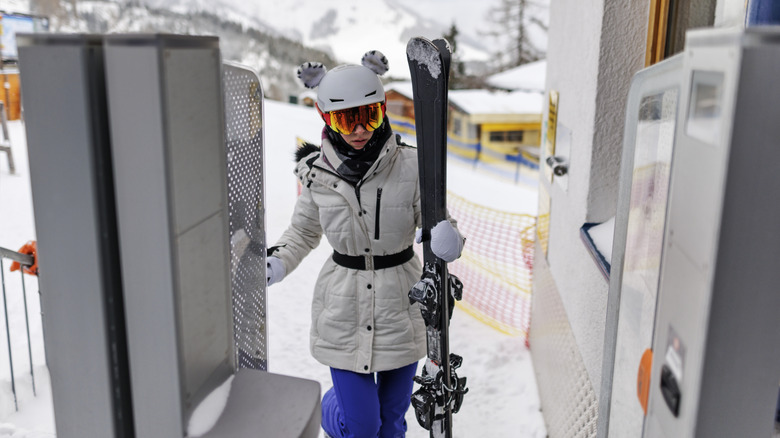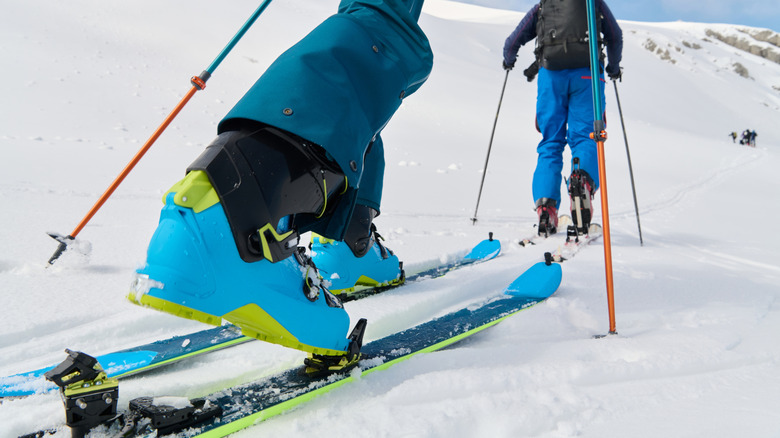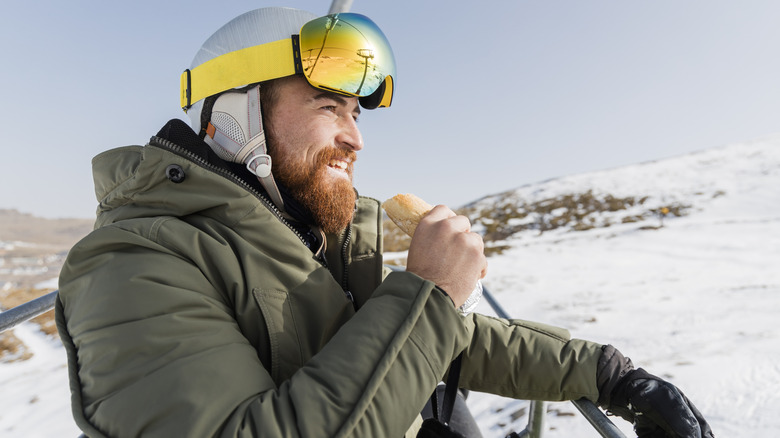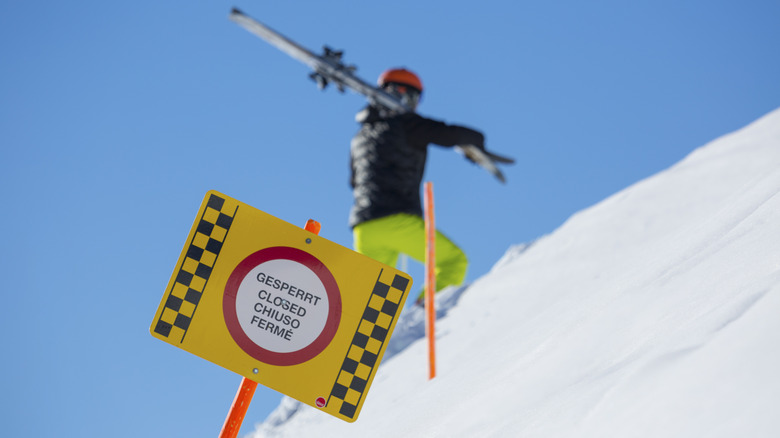Avoid Making These Rookie Mistakes On Your First Ski Trip
Anyone who has watched the Winter Olympics knows how easy the athletes make skiing look. How many have sat there watching these professional athletes glide flawlessly down the mountain thinking, "Psh, I could do that"? Unfortunately for those who have never skied before, it's just a bit harder than the pros make it seem. Sadly, unless you've been practicing diligently from a young age, you probably won't be packing your bags and going for gold any time soon.
You can, however, learn a few tips and tricks to make your first trip to the mountain a memorable one (and not because you crashed into a tree). For those feeling inspired by the greats to take their aim at conquering the slopes, there are a few rules and unspoken codes of conduct to follow, as well as a few things to avoid to ensure your safety and the safety of others on the slopes.
Know your body before skiing
This may seem like an obvious one, but many who have gone skiing for the first time can attest to the pain they feel radiating through their bodies the next day. Pro-tip for those looking to tackle the slopes: Prepare yourself physically. Understandably, not everyone has the time to hit the gym 10 times a week before heading off on their winter vacation, but making sure you are in good enough shape to hit the slopes will help reduce fatigue and injury, making your trip much more enjoyable. Don't get discouraged if you fall — your tailbone will probably be bruised the next day, but that doesn't mean your ego should be. Know that failing is all part of the process, and try not to let it frustrate you too much.
Next up, know your skill level. If you are new to the slopes, then you'll want to book tickets to a resort with a decent percentage of beginner terrain. While tempting, a resort with mostly black diamond trails is probably not the best option if you're still learning your "pizzas" and "french fries." Booking tickets at a resort in places like Buttermilk Mountain in Colorado or Dollar Mountain at Sun Valley in Idaho is a great idea, as each comes with more than enough space for beginners to widely wind their way down the mountain. Omio, a transportation booking platform, released a study in 2024 showing the best resorts for novice skiers, with Ski Arlberg in Austria coming in at number one (via Time Out). Doing the proper research will ensure you aren't booking at a resort that only the pros prefer.
Book your ski trip ahead of time
A mistake that many first-timers make is planning an entire ski vacation without booking their lift tickets or lessons ahead of time. It seems like a silly mistake to make, but sometimes you become so overwhelmed with planning flights and hotels that you forget the most important part: the skiing itself. Booking in advance will save you from stress, as reservations fill up quickly and some resorts don't sell tickets the day-of. Grabbing your tickets ahead of your visit will also save your wallet from crying, as many resorts offer cheaper prices the earlier you book. Check the resort's website for multiday passes or lesson and lift packages, or if you plan on visiting multiple times in the season, see whether or not the resort offers seasonal passes.
Speaking of lessons: No matter your age, you shouldn't feel embarrassed to learn how to ski properly. While some people want to take a shortcut and have their friend Karl teach them the ropes, most of the time it's better to get a professional to show you how. Learning to ski is fun, but it can also be dangerous if the proper precautions aren't taken, both for you and those around you. Lessons with an instructor will ensure you learn the necessary skills — from how to ride and exit the chair lift, to controlling your speed and turns, there are many things to know that Karl probably won't teach you.
Know what to pack for your ski vacation
Although most travelers love to procrastinate when it comes to packing, unfortunately, a ski trip is not the right time. Making sure you are prepared with the proper gear is key to ensuring a pleasant experience on the mountain. Some people worry about being too bulky if they wear too many layers, but there is a way to be prepared without feeling like Randy from "A Christmas Story." It's also important to check the weather conditions on the day you plan to ski, to be fully prepped for the gear you may need. As the common understanding goes: You can always remove a layer but can't add one you didn't bring. Layering is an essential part of packing for any cold-weather trip, and this is especially true for skiing. You'll want to purchase thinner, sweat-wicking layers as your base and thicker waterproof layers to wear on top.
Anyone who has skied before knows how uncomfortable ski boots can be — and if you don't, prepare yourself. One of the biggest mistakes beginners can make when choosing a ski boot is to assume it should fit like a sneaker. Ski boots should be more snug, meaning there shouldn't be room for your foot to shift or move around. If you buy ski boots that are too big, you risk causing blisters and bruising from the constant rubbing. According to Ski Magazine, professional bootfitter Sam Tischendorf stated, "Know that the boot is going to be at its tightest when trying it on in the store, and it's going to become more spacious over time. So, err on the side of feeling contained."
Prep with food and sunscreen
Spending a day on the slopes can be exhausting, and most beginners probably don't think about how famished they'll feel. To stay energized and hydrated, bring a few snacks and a collapsible water bottle up with you on the mountain. Food like nuts, power bars, or beef jerky. are a great source of protein and will help keep you going. Although most resorts have a restaurant, your wallet will thank you for bringing your own food along.
This may come as a surprise, but you can get a sunburn, even in the snow. Of course, most of your body will probably be covered, but a rookie mistake is to think your face won't get sunburnt just because you're in the snow. In a piece by the Better Health Channel that explains how the sun can impact you even in the winter, the author writes, "On a sunny day, fresh snow can reflect up to 90% of UV radiation." With this in mind, invest in some sunscreen and good goggles or a pair of sunglasses to help protect your face and eyes from the sun.
Follow the rules on your next ski trip
Each ski resort comes with its own set of rules, and it's up to you to make sure you research this before hitting the slopes. It's also important to realize what the signs mean: Green is for beginners, blue is for intermediate, red is for advanced, and black is for expert. The last thing you want to do is find yourself accidentally on a black diamond run with no way to get down (though, on your butt is always an option). According to the National Ski Areas Association, there are rules skiers should follow to ensure mountain safety. Of course, some of these are easier said than done, but it is important for first-timers to familiarize themselves before hitting the slopes.
First, skiers should stay in control, stopping or avoiding people or objects. People ahead of you and people skiing downhill have the right-of-way, so make sure you yield as appropriate. Don't stop where people can't see you, especially right in front of a jump, lest you want to be landed on. You're in charge of preventing runaway equipment, meaning if your ski falls off and starts flying down the mountain, you better chase after it. Skiers must "read and obey all signs, warnings, and hazard markings," and keep off all areas that are closed to the public. Learn how to properly get on and off the chair lift, and if you need help, ask an attendant. Although it's tempting to chug a few drinks before heading down the mountain, it's best to keep the drinking to a minimum. Most importantly, if you are involved in an accident with another skier, share your contact info and let an employee know. Following these rules will ensure you have the perfect ski trip.
